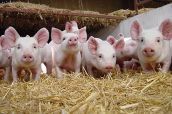Lallemand: Piglet survival hinges on farrowing

Piglet vitality at birth is key for survival during the first days of life. This is one of the preliminary results of a recent study concluded by Lallemand Animal Nutrition, France.
Piglet vitality, in turn, is influences by the quality of the farrowing process. Hence, the farrowing process has direct consequences on overall farm overall performance. The French animal nutrition company is involved in the process as its product Levucell SB (a live yeast, Saccharomyces cerevisiae boulardii) is aimed at allowing an easier and more efficient farrowing process.
Farrowing conditions and still-birth
During a recent study on a pig farm in Brittany, sows were ranked in three groups according to the difficulty of the farrowing process (easy, average, difficult). This scoring scale took into account the duration of the process as well as the frequency of interventions (manual or pharmacological).
There is a strong correlation between the difficulty of the farrowing process and the proportion of stillbirth: the latter increases from 7.7% for the ‘easy’ group to 12.7% for the ‘difficult’ one.
Main risk factors
Several factors can account for this correlation between farrowing conditions and still-birth rate:
· Hypoxia risks: partial CO2 pressure in the piglets blood increases with farrowing duration, and thus with the number of piglets born and birth rank.
· Manual or pharmacological (synthetic hormones injections) interventions, can greatly affect piglets status by provoking fetal acidosis, bradycardia… and even internal haemorrhages due to the strong contractions.
Day 3 mortality
The influence of the farrowing conditions sprean beyond the birth day, to the first days of life. Indeed, even when the risk factors mentioned above do not cause piglet death at birth, they can affect its vitality. During the research project, each piglet’s vitality was assessed according to its behaviour within the first 15 seconds following expulsion.
Interestingly, there is a correlation between the piglets’ average vitality at birth and the duration of the farrowing process: the longer the farrowing, the least vigorous the piglet tends to be.
Vitality at birth: an interesting prediction tool
The study shows that piglets’ vitality at birth is a key factor of their survival during the first days of life: mortality rate at day 3 drops when the vitality score increases, and the survival chances of piglets with very low vitality score are extremely poor. When the farrowing process is long and difficult, piglets are weakened, they are less mobile, less strong, and will reach the teat later. Milk extraction will be delayed and more difficult for them.
It is now established that colustrum intake is key to piglet survival: colustrum quality, both on the immunity and energy point of view, quickly drops with time. Both the colustrum and early lactation phases can be disturbed if the farrowing conditions are poor, thus increasing piglets mortality.
Related website:
Lallemand











